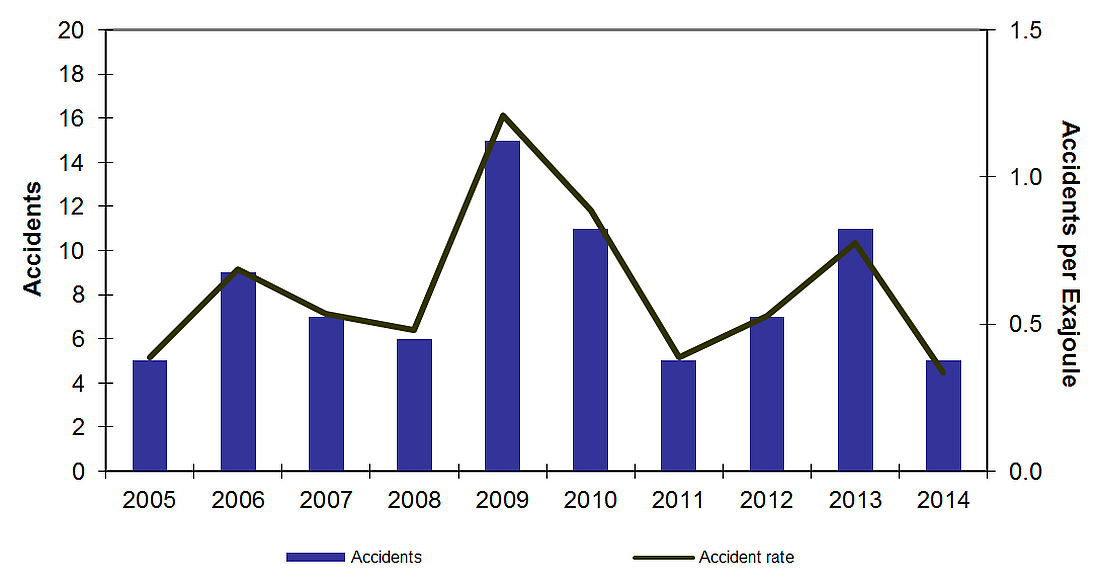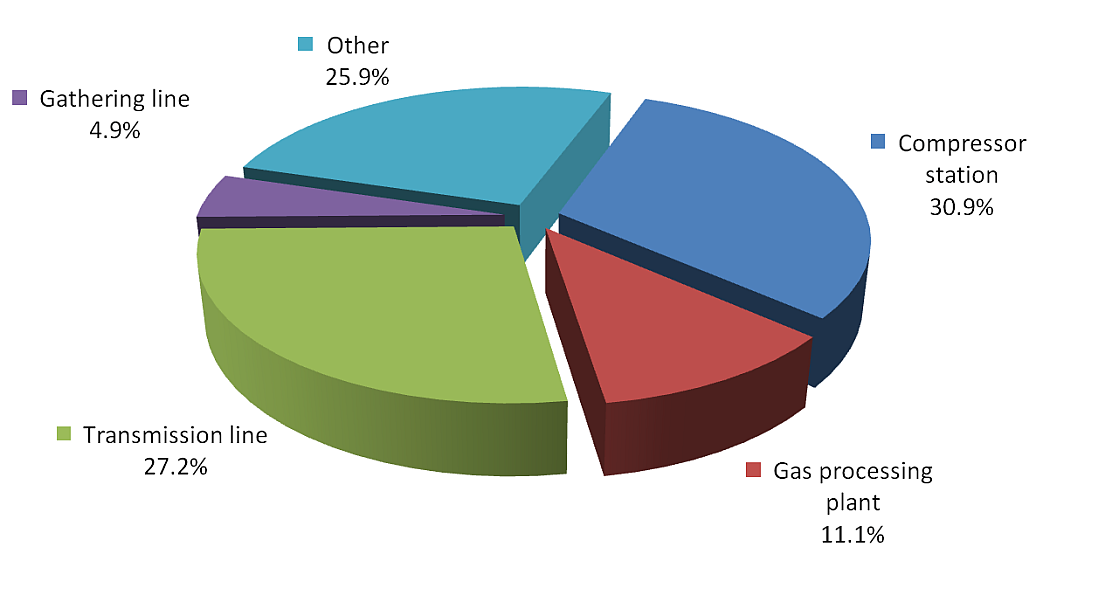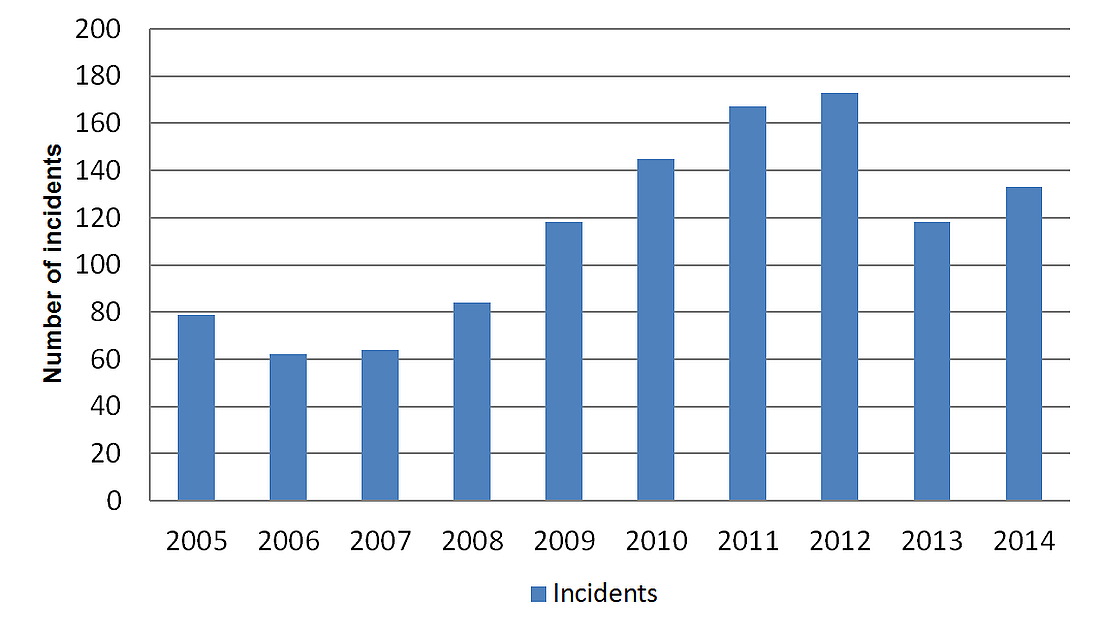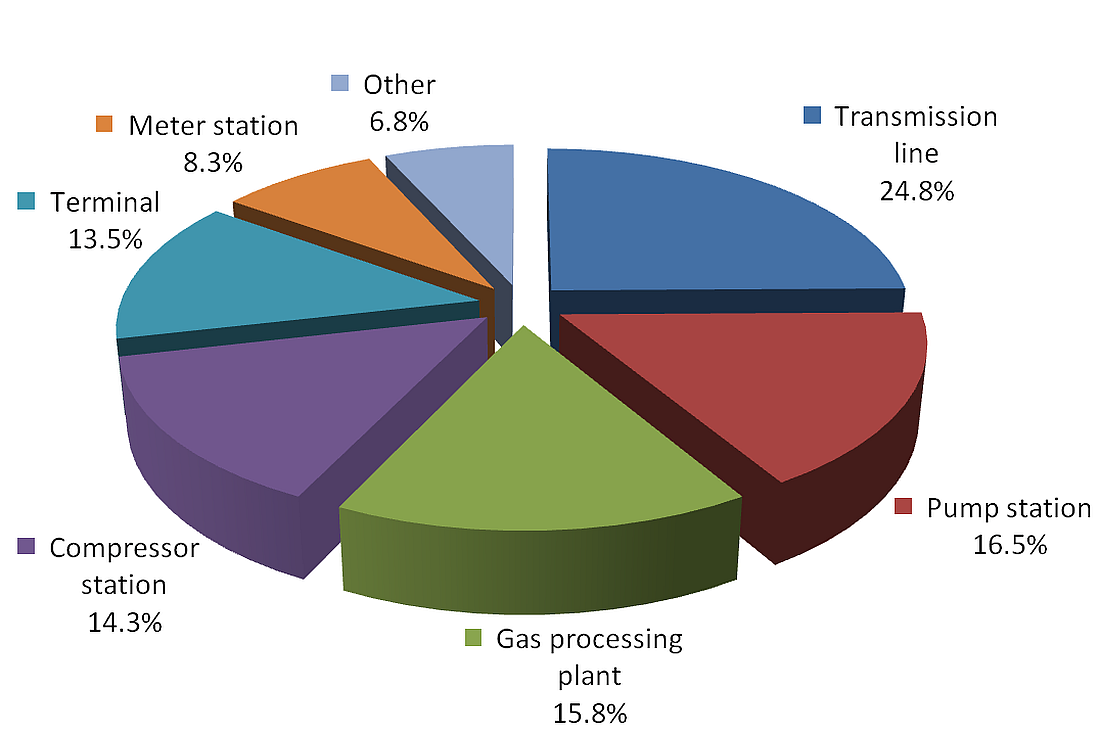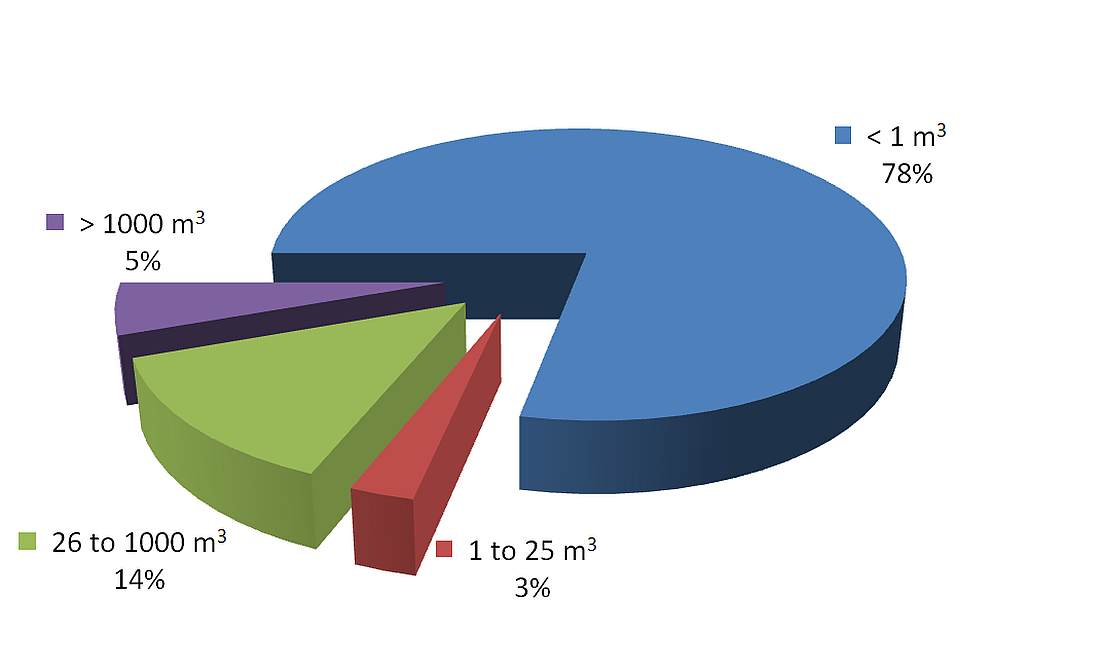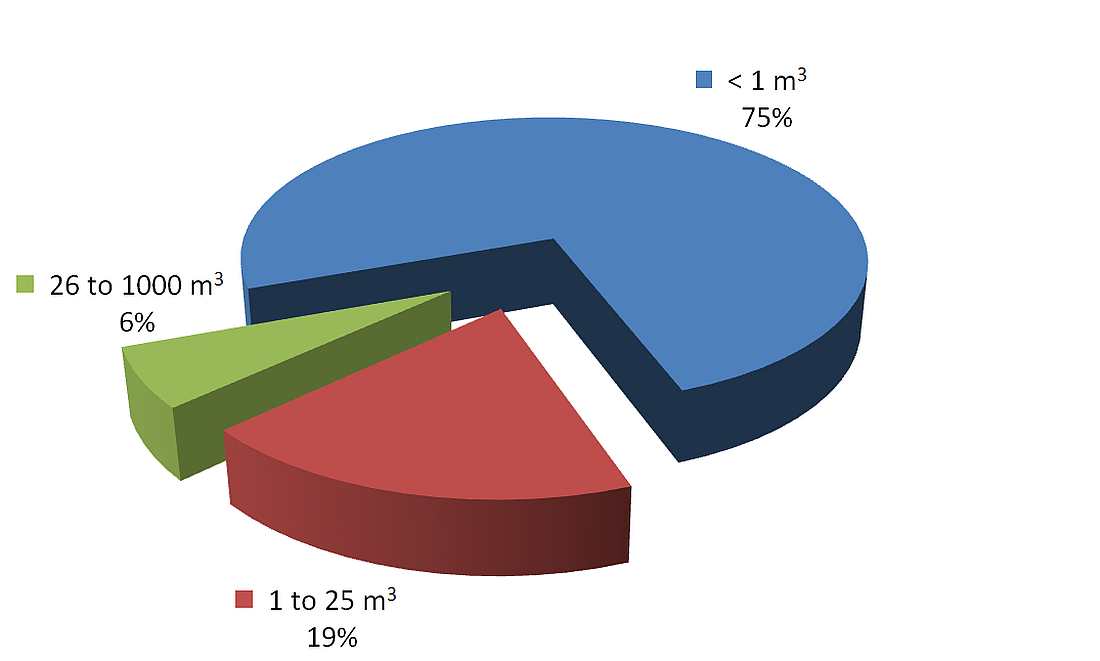Foreword
This document provides Canadians with an annual summary of selected pipeline safety data. It covers federally regulated pipelines only. Non-federally regulated data reported to the Transportation Safety Board of Canada (TSB) are not included in this report. The TSB gathers and uses this data during the course of our investigations to analyse safety deficiencies and identify risks in the Canadian transportation system.
On 12 March 2014, the TSB issued new regulations that changed the reporting requirements effective 01 July 2014. These changes are reflected in the 2014 Statistical Summary.
Users of these statistics are advised that, in a live database, the occurrence data are constantly being updated. Consequently, the statistics may change slightly over time. Further, as many occurrences are not formally investigated, information recorded on some occurrences may not have been verified. The 2014 statistics presented here reflect the TSB database updated as of 13 February 2015.
To enhance awareness and increase the safety value of the material presented in the TSB Statistical Summary, Pipeline Occurrences 2014, readers are encouraged to copy or reprint in whole, or in part, for further distribution of the data presented (with acknowledgement of the source).
The TSB is an independent agency operating under its own Act of Parliament. Its sole aim is the advancement of transportation safety.
Comments on this document can be forwarded to the following address:
Transportation Safety Board of Canada
Communications Branch
Place du Centre
200 Promenade du Portage
4th Floor
Gatineau, Quebec
K1A 1K8
Telephone: 819-994-3741
Facsimile: 819-997-2239
E-mail: communications@bst-tsb.gc.ca
Pipeline system
In 2014, in the federally-regulated pipeline system, 37 companies, including 11 that transport both oil and gas, transported 216 million cubic metres (m³) of oil (1.4 billion barrels) along 21 636 kilometres of oil pipelines. Sixty-seven companies, including the 11 that transport both oil and gas, transported 152 billion cubic metres of natural gas (5.4 trillion cubic feet) along 55 982 kilometres of natural gas pipelines.Footnote 1
Accidents
Overview of accidents and casualties
Five pipeline accidentsFootnote 2 (Table 1) were reported to the TSB in 2014, down from a total of 11 in 2013 and down from the annual average of 10 in the previous 5 year period (2009–2013).
Pipeline activity increased 6% from 2013Footnote 3. An indicator of pipeline transportation safety in Canada is the pipeline accident rate. The 2014 rate (Table 2) was 0.3 pipeline accidents per exajouleFootnote 4, down from 0.8 in 2013, and down from the annual average of 0.8 in 2009–2013 (Figure 1).
Figure 1 data
| Year | Accidents | Accident rate |
|---|---|---|
| 2005 | 5 | 0.39 |
| 2006 | 9 | 0.69 |
| 2007 | 7 | 0.53 |
| 2008 | 6 | 0.48 |
| 2009 | 15 | 1.21 |
| 2010 | 11 | 0.89 |
| 2011 | 5 | 0.39 |
| 2012 | 7 | 0.53 |
| 2013 | 11 | 0.77 |
| 2014 | 5 | 0.33 |
Location of accidents: Over the past 10 years (2005–2014), 42% of pipeline accidents (Table 4) occurred at compressor stations and gas processing plants, and 27% occurred on transmission lines (Figure 2). The remaining pipeline accidents (31%) occurred at pump stations, terminals, meter stations, and on gathering lines.
In 2014, 2 pipeline accidents involved line pipe and 3 pipeline accidents occurred at facilities (2 at compressor stations and 1 at a transmission line remote valve site).
Figure 2 data
| Facility type | Number | Percentage |
|---|---|---|
| Compressor station | 25 | 30.9 |
| Gas processing plant | 9 | 11.1 |
| Transmission line | 22 | 27.2 |
| Gathering line | 4 | 4.9 |
| Other | 21 | 25.9 |
Fatalities: The last fatal accident on a federally-regulated pipeline system occurred in 1988.
Release of product: In 2014, two accidents with release of product occurred. Both resulted in the release of over 1 000 cubic metres of natural gas. Over the past 10 years (2005-2014), 44 of the 81 accidents (Table 5 & Table 6) resulted in a release of product. Natural gas was released in 21 accidents, with 7 releases of less than 1 cubic metre, 2 releases between 1 and 25 cubic metres, 2 releases between 25 and 1 000 cubic metres, and 10 releases over 1 000 cubic metres. Crude oil was released in 14 accidents, with 8 releases of less than 1 cubic metre (6.29 barrels (bbl)), 2 releases between 1 and 25 cubic metres (between 6.29 barrels and 157 bbl), 3 releases between 25 and 1 000 cubic metres (between 157 and 6 290 bbl), and 1 release over 1 000 cubic metres (6 290 bbl).
IncidentsFootnote 7
In 2014, 133 pipeline incidentsFootnote 8 (Table 1, Figure 3) were reported to the TSB, up from 118 in 2013 but down from the annual average of 144 in the previous 5 years (2009-2013). With the new TSB Regulations in effect starting 01 July 2014, there was a decrease in the number of incidents involving releases of low vapour pressure hydrocarbons in the last 6 months of the year. As the new TSB Regulations introduced the definition of “safety zone” (see Appendix B) to include 30 metres to each side of a pipeline, there was an increase in the number of incidents involving disturbance of supporting environment /no release in the last 6 months of the year.
Figure 3 data
| Year | Incidents |
|---|---|
| 2005 | 79 |
| 2006 | 62 |
| 2007 | 64 |
| 2008 | 84 |
| 2009 | 118 |
| 2010 | 145 |
| 2011 | 167 |
| 2012 | 173 |
| 2013 | 118 |
| 2014 | 133 |
Location of incidents: In 2014, 25% of pipeline incidents (Table 4) occurred on transmission lines, followed by 17% at pump stations, 16% at gas processing plants, 14% at compressor stations, 14% at terminals, and 8% at meter stations. The remaining incidents occurred on gathering lines, at an injection/delivery facility, or at other facilities (Figure 4).
Figure 4 data
| Facility type | Number | Percentage |
|---|---|---|
| Transmission line | 33 | 24.8% |
| Pump station | 22 | 16.5% |
| Gas processing plant | 21 | 15.8% |
| Compressor station | 19 | 14.3% |
| Terminal | 18 | 13.5% |
| Meter station | 11 | 8.3% |
| Other | 9 | 6.8% |
Release of product: In 2014, 59% of the incidents (Table 1 and Table 6) involved a release of less than 1 cubic metre of gas, oil, other petroleum product, or non-petroleum product (e.g., sulphur, ethylene glycol) and 22% of the incidents involved no release of product. Six incidents involved a release of 1 to 25 cubic metres (between 6.29 and 157 bbl) of crude oil, and 2 incidents involved a release of 25 to 1 000 cubic metres (between 157 and 6 290 bbl) of crude oil. Five incidents involved a release of 25 to 1 000 cubic metres of natural gas, and one incident involved a release of 25 to 1 000 cubic metres of sour gas. Two incidents involved a release of over 1 000 cubic metres (2 100 m³ and 160 000 m³ respectively) of natural gas (Figure 5). One incident involved a release of 63 cubic metres of sulphur.
Figure 5 data
| Quantity of release | Number | Percentage |
|---|---|---|
| < 1 m³ | 29 | 78% |
| 1 to 25 m³ | 1 | 3% |
| 26 to 1000 m³ | 5 | 14% |
| > 1000 m³ | 2 | 5% |
Natural gas releases of less than 1 cubic metre decreased from 41 in 2013 (41% of all product releases) to 29 in 2014 (28% of all product releases).
Figure 6 data
| Quantity of release | Number | Percentage |
|---|---|---|
| < 1 m³ | 24 | 75% |
| 1 to 25 m³ | 6 | 19% |
| 26 to 1000 m³ | 2 | 6% |
Crude oil releases of less than 1 cubic metre (6.29 barrels) decreased from 27 in 2013 (27% of all product releases) to 24 in 2014 (23% of all product releases).
Appendices
Appendix A: Pipeline ocurrence tables
| 2005 | 2006 | 2007 | 2008 | 2009 | 2010 | 2011 | 2012 | 2013 | 2014 | |
|---|---|---|---|---|---|---|---|---|---|---|
| Accidents | 5 | 9 | 7 | 6 | 15 | 11 | 5 | 7 | 11 | 5 |
| Total, line pipe | 2 | 1 | 2 | 0 | 6 | 1 | 2 | 1 | 2 | 2 |
| 3rd party damage with release | 1 | 1 | 1 | 0 | 0 | 0 | 0 | 0 | 0 | 0 |
| Disturbance of supporting environment with release | 0 | 0 | 0 | 0 | 0 | 0 | 0 | 0 | 0 | 0 |
| Corrosion/Environmental cracking | 0 | 0 | 0 | 0 | 0 | 0 | 1 | 0 | 0 | 0 |
| Fire/Ignition/Explosion | 1 | 0 | 0 | 0 | 3 | 0 | 1 | 1 | 2 | 1 |
| Other damage with release | 0 | 0 | 1 | 0 | 3 | 1 | 0 | 0 | 0 | 1 |
| Total, other facilities (a) | 3 | 8 | 5 | 6 | 9 | 10 | 3 | 6 | 9 | 3 |
| 3rd party damage | 0 | 1 | 1 | 1 | 1 | 2 | 1 | 1 | 1 | 0 |
| Corrosion/Environmental cracking | 0 | 0 | 0 | 0 | 0 | 0 | 0 | 0 | 0 | 0 |
| Fire/Ignition/Explosion | 3 | 6 | 4 | 4 | 7 | 6 | 2 | 5 | 8 | 3 |
| Other damage with release | 0 | 1 | 0 | 1 | 1 | 2 | 0 | 0 | 0 | 0 |
| Accidents with a release of product | 3 | 2 | 3 | 3 | 9 | 8 | 4 | 3 | 7 | 2 |
| Accidents with casualties | 0 | 1 | 0 | 0 | 1 | 0 | 0 | 1 | 0 | 0 |
| Accidents with environmental damage | 0 | 0 | 1 | 0 | 1 | 0 | 1 | 1 | 0 | 0 |
| Accidents with a fire | 4 | 5 | 4 | 4 | 11 | 6 | 3 | 6 | 8 | 4 |
| Accidents with an explosion | 0 | 1 | 0 | 0 | 1 | 0 | 1 | 1 | 0 | 1 |
| Incidents* | 79 | 62 | 64 | 84 | 118 | 145 | 167 | 173 | 118 | 133 |
| Total, line pipe | 21 | 11 | 14 | 13 | 20 | 16 | 18 | 18 | 21 | 26 |
| 3rd party damage no release | 0 | 3 | 2 | 3 | 5 | 2 | 1 | 3 | 1 | 3 |
| Disturbance of supporting environment no release | 3 | 0 | 1 | 0 | 1 | 0 | 2 | 2 | 1 | 12 |
| Uncontained release | 16 | 5 | 9 | 5 | 9 | 7 | 12 | 12 | 15 | 4 |
| Other | 2 | 3 | 2 | 5 | 5 | 7 | 3 | 1 | 4 | 7 |
| Total, other facilities | 58 | 51 | 50 | 71 | 98 | 129 | 149 | 155 | 97 | 107 |
| 3rd party damage no release | 0 | 0 | 0 | 2 | 1 | 0 | 0 | 1 | 2 | 4 |
| Uncontained release | 54 | 51 | 45 | 61 | 86 | 119 | 124 | 140 | 83 | 97 |
| Other | 4 | 0 | 5 | 8 | 11 | 10 | 25 | 14 | 12 | 6 |
| Incidents with a release of product | 72 | 56 | 56 | 69 | 96 | 129 | 147 | 154 | 100 | 104 |
| Incidents with casualties | 0 | 0 | 0 | 0 | 0 | 0 | 0 | 0 | 0 | 0 |
| Incidents with environmental damage | 0 | 1 | 0 | 0 | 1 | 0 | 0 | 1 | 0 | 0 |
| Incidents with a fire | 0 | 1 | 1 | 5 | 0 | 1 | 9 | 6 | 1 | 2 |
| Incidents with an explosion | 0 | 0 | 0 | 0 | 1 | 0 | 0 | 0 | 0 | 0 |
Federally regulated pipeline occurrences. In 2009, there was a 38% increase in the size of the federally regulated pipeline system when an additional 23 705 kilometres of pipeline and associated facilities were transferred from provincial jurisdiction. *New TSB regulations came into effect on July 1, 2014. Under the new reporting requirements the minimum reporting threshold for incidents with release has been changed to be the same as NEB regulations which is 1.5 m3 of low vapour pressure hydrocarbons. Data extracted February 13, 2015. |
||||||||||
| 2005 | 2006 | 2007 | 2008 | 2009 | 2010 | 2011 | 2012 | 2013 | 2014 | |
|---|---|---|---|---|---|---|---|---|---|---|
| Accidents | 5 | 9 | 7 | 6 | 15 | 11 | 5 | 7 | 11 | 5 |
| Natural gas products (exajoules) | 6.6 | 6.6 | 6.5 | 6.2 | 5.9 | 5.6 | 5.6 | 5.3 | 6.1 | 5.6 |
| Petrolium products (exajoules) | 6.3 | 6.5 | 6.6 | 6.3 | 6.5 | 6.8 | 7.3 | 8.0 | 8.1 | 9.4 |
| Total (exajoules) | 12.9 | 13.1 | 13.1 | 12.5 | 12.4 | 12.4 | 12.9 | 13.3 | 14.2 | 15.0 |
| Number of accidents per exajoule | 0.39 | 0.69 | 0.53 | 0.48 | 1.21 | 0.89 | 0.39 | 0.53 | 0.77 | 0.33 |
Data extracted February 13, 2015. Federally regulated pipeline occurrences. Source: National Energy Board (estimated). |
||||||||||
| 2005 | 2006 | 2007 | 2008 | 2009 | 2010 | 2011 | 2012 | 2013 | 2014 | |
|---|---|---|---|---|---|---|---|---|---|---|
| Accidents | 5 | 9 | 7 | 6 | 15 | 11 | 5 | 7 | 11 | 5 |
| Newfoundland and Labrador | 0 | 0 | 0 | 0 | 0 | 0 | 0 | 0 | 0 | 0 |
| Prince Edward Island | 0 | 0 | 0 | 0 | 0 | 0 | 0 | 0 | 0 | 0 |
| Nova Scotia | 0 | 0 | 0 | 0 | 0 | 0 | 0 | 0 | 0 | 0 |
| New Brunswick | 0 | 0 | 0 | 0 | 0 | 0 | 0 | 0 | 0 | 0 |
| Quebec | 0 | 0 | 0 | 0 | 0 | 0 | 0 | 0 | 0 | 0 |
| Ontario | 1 | 1 | 2 | 1 | 5 | 2 | 2 | 2 | 2 | 0 |
| Manitoba | 0 | 2 | 1 | 1 | 0 | 1 | 0 | 0 | 0 | 1 |
| Saskatchewan | 1 | 0 | 1 | 0 | 2 | 1 | 1 | 1 | 1 | 0 |
| Alberta | 1 | 1 | 0 | 0 | 4 | 4 | 1 | 2 | 6 | 2 |
| British Columbia | 2 | 5 | 3 | 4 | 4 | 3 | 0 | 2 | 2 | 1 |
| Yukon | 0 | 0 | 0 | 0 | 0 | 0 | 0 | 0 | 0 | 0 |
| Northwest Territories | 0 | 0 | 0 | 0 | 0 | 0 | 1 | 0 | 0 | 1 |
| Nunavut | 0 | 0 | 0 | 0 | 0 | 0 | 0 | 0 | 0 | 0 |
| Incidents* | 79 | 62 | 64 | 84 | 118 | 145 | 167 | 173 | 118 | 133 |
| Newfoundland and Labrador | 0 | 0 | 0 | 0 | 0 | 0 | 0 | 0 | 0 | 0 |
| Prince Edward Island | 0 | 0 | 0 | 0 | 0 | 0 | 0 | 0 | 0 | 0 |
| Nova Scotia | 1 | 1 | 2 | 1 | 0 | 1 | 5 | 2 | 3 | 2 |
| New Brunswick | 0 | 0 | 1 | 0 | 5 | 6 | 14 | 19 | 16 | 9 |
| Quebec | 4 | 1 | 3 | 2 | 4 | 2 | 2 | 1 | 1 | 1 |
| Ontario | 7 | 7 | 8 | 17 | 20 | 19 | 22 | 22 | 10 | 20 |
| Manitoba | 3 | 7 | 4 | 10 | 9 | 14 | 11 | 10 | 12 | 8 |
| Saskatchewan | 23 | 14 | 10 | 17 | 13 | 38 | 35 | 45 | 18 | 17 |
| Alberta | 21 | 11 | 11 | 16 | 36 | 51 | 55 | 45 | 35 | 35 |
| British Columbia | 16 | 20 | 23 | 19 | 26 | 13 | 11 | 18 | 17 | 41 |
| Yukon | 0 | 0 | 0 | 0 | 0 | 0 | 0 | 0 | 0 | 0 |
| Northwest Territories | 4 | 1 | 2 | 2 | 5 | 1 | 12 | 11 | 6 | 0 |
| Nunavut | 0 | 0 | 0 | 0 | 0 | 0 | 0 | 0 | 0 | 0 |
Data extracted February 13, 2015. Federally regulated pipeline occurrences. * New TSB regulations came into effect on July 1, 2014. Under the new reporting requirements the minimum reporting threshold for incidents with release has been changed to be the same as NEB regulations which is 1.5 m³ of low vapour pressure hydrocarbons. |
||||||||||
| 2005 | 2006 | 2007 | 2008 | 2009 | 2010 | 2011 | 2012 | 2013 | 2014 | |
|---|---|---|---|---|---|---|---|---|---|---|
| Accidents | 5 | 9 | 7 | 6 | 15 | 11 | 5 | 7 | 11 | 5 |
| Compressor station | 0 | 4 | 2 | 2 | 3 | 5 | 0 | 3 | 4 | 2 |
| Gathering line | 0 | 0 | 1 | 0 | 1 | 1 | 0 | 1 | 0 | 0 |
| Injection/Delivery facility | 0 | 0 | 0 | 0 | 0 | 0 | 0 | 0 | 0 | 0 |
| Meter station | 0 | 1 | 0 | 1 | 0 | 1 | 2 | 1 | 0 | 0 |
| Gas processing plant | 1 | 1 | 0 | 2 | 3 | 0 | 0 | 0 | 2 | 0 |
| Pump station | 1 | 1 | 1 | 0 | 1 | 1 | 0 | 2 | 1 | 0 |
| Storage facility | 0 | 0 | 0 | 0 | 0 | 0 | 0 | 0 | 0 | 0 |
| Terminal | 1 | 1 | 0 | 1 | 0 | 2 | 1 | 0 | 1 | 0 |
| Transmission line | 2 | 1 | 3 | 0 | 7 | 1 | 2 | 0 | 3 | 3 |
| Other | 0 | 0 | 0 | 0 | 0 | 0 | 0 | 0 | 0 | 0 |
| Incidents* | 79 | 62 | 64 | 84 | 118 | 145 | 167 | 173 | 118 | 133 |
| Compressor station | 10 | 8 | 8 | 20 | 32 | 26 | 22 | 31 | 15 | 19 |
| Gathering line | 8 | 5 | 5 | 5 | 9 | 7 | 7 | 8 | 2 | 4 |
| Injection/Delivery facility | 0 | 0 | 0 | 0 | 0 | 1 | 1 | 0 | 1 | 1 |
| Meter station | 1 | 1 | 5 | 2 | 14 | 21 | 20 | 17 | 19 | 11 |
| Gas processing plant | 7 | 9 | 4 | 8 | 8 | 5 | 3 | 6 | 11 | 21 |
| Pump station | 27 | 18 | 15 | 20 | 26 | 30 | 48 | 37 | 19 | 22 |
| Storage facility | 0 | 0 | 0 | 1 | 0 | 0 | 1 | 1 | 0 | 0 |
| Terminal | 11 | 8 | 11 | 10 | 13 | 21 | 27 | 35 | 19 | 18 |
| Transmission line | 13 | 12 | 14 | 17 | 16 | 32 | 31 | 33 | 30 | 33 |
| Other | 2 | 1 | 2 | 1 | 0 | 2 | 7 | 5 | 2 | 4 |
Data extracted February 13, 2015. Federally regulated pipeline occurrences. * New TSB regulations came into effect on July 1, 2014. Under the new reporting requirements the minimum reporting threshold for incidents with release has been changed to be the same as NEB regulations which is 1.5 m³ of low vapour pressure hydrocarbons. |
||||||||||
| 2005 | 2006 | 2007 | 2008 | 2009 | 2010 | 2011 | 2012 | 2013 | 2014 | |
|---|---|---|---|---|---|---|---|---|---|---|
| Accidents | 3 | 2 | 3 | 3 | 9 | 8 | 4 | 3 | 7 | 2 |
| Condensate | 0 | 0 | 0 | 0 | 0 | 0 | 0 | 0 | 0 | 0 |
| Liquified petroleum gas | 0 | 0 | 0 | 1 | 0 | 0 | 0 | 0 | 0 | 0 |
| Natural gas | 1 | 1 | 1 | 0 | 5 | 3 | 2 | 2 | 4 | 2 |
| Natural gas liquids | 0 | 0 | 0 | 0 | 0 | 0 | 0 | 0 | 0 | 0 |
| Petroleum crude oil | 1 | 1 | 2 | 1 | 1 | 4 | 2 | 0 | 2 | 0 |
| Refined products | 0 | 0 | 0 | 0 | 1 | 0 | 0 | 0 | 0 | 0 |
| Sour gas | 0 | 0 | 0 | 0 | 1 | 0 | 0 | 1 | 1 | 0 |
| Well effluent | 0 | 0 | 0 | 0 | 0 | 0 | 0 | 0 | 0 | 0 |
| Sour condensate | 0 | 0 | 0 | 0 | 0 | 0 | 0 | 0 | 0 | 0 |
| Sour crude oil | 0 | 0 | 0 | 0 | 0 | 0 | 0 | 0 | 0 | 0 |
| Acid gas | 0 | 0 | 0 | 0 | 0 | 0 | 0 | 0 | 0 | 0 |
| Other | 1 | 0 | 0 | 1 | 1 | 1 | 0 | 0 | 0 | 0 |
| Incidents* | 72 | 56 | 56 | 69 | 96 | 129 | 147 | 154 | 100 | 104 |
| Condensate | 0 | 1 | 0 | 1 | 1 | 2 | 0 | 0 | 3 | 4 |
| Liquified petroleum gas | 1 | 1 | 0 | 1 | 1 | 2 | 1 | 1 | 0 | 3 |
| Natural gas | 16 | 14 | 19 | 26 | 37 | 55 | 59 | 63 | 45 | 37 |
| Natural gas liquids | 5 | 1 | 0 | 0 | 0 | 0 | 4 | 1 | 5 | 4 |
| Petroleum crude oil | 38 | 24 | 24 | 28 | 32 | 54 | 71 | 77 | 31 | 32 |
| Refined products | 1 | 2 | 1 | 1 | 2 | 4 | 0 | 2 | 0 | 0 |
| Sour gas | 6 | 3 | 6 | 1 | 7 | 2 | 2 | 4 | 2 | 4 |
| Well effluent | 0 | 0 | 0 | 0 | 0 | 0 | 0 | 0 | 0 | 0 |
| Sour condensate | 0 | 0 | 0 | 0 | 0 | 0 | 0 | 0 | 0 | 0 |
| Sour crude oil | 0 | 0 | 0 | 0 | 0 | 0 | 0 | 0 | 1 | 0 |
| Acid gas | 2 | 0 | 0 | 1 | 0 | 0 | 1 | 0 | 0 | 0 |
| Other | 3 | 10 | 6 | 10 | 16 | 10 | 9 | 6 | 13 | 20 |
Data extracted February 13, 2015. Federally regulated pipeline occurrences. * New TSB regulations came into effect on July 1, 2014. Under the new reporting requirements the minimum reporting threshold for incidents with release has been changed to be the same as NEB regulations which is 1.5 m³ of low vapour pressure hydrocarbons. |
||||||||||
| 2005 | 2006 | 2007 | 2008 | 2009 | 2010 | 2011 | 2012 | 2013 | 2014 | |
|---|---|---|---|---|---|---|---|---|---|---|
| Accidents | 3 | 2 | 3 | 3 | 9 | 8 | 4 | 3 | 7 | 2 |
| Less than 1 cubic metre | 2 | 0 | 0 | 3 | 3 | 8 | 1 | 2 | 5 | 0 |
| 1 to 25 cubic metres | 1 | 1 | 1 | 0 | 1 | 0 | 0 | 0 | 0 | 0 |
| 26 to 1000 cubic metres | 0 | 1 | 2 | 0 | 0 | 0 | 2 | 0 | 0 | 0 |
| Greater than 1000 cubic metres | 0 | 0 | 0 | 0 | 5 | 0 | 1 | 1 | 2 | 2 |
| Incidents* | 72 | 56 | 56 | 69 | 96 | 129 | 147 | 154 | 100 | 104 |
| Less than 1 cubic metre | 57 | 47 | 45 | 53 | 87 | 119 | 124 | 147 | 89 | 78 |
| 1 to 25 cubic metres | 9 | 4 | 7 | 13 | 5 | 5 | 13 | 4 | 8 | 15 |
| 26 to 1000 cubic metres | 4 | 5 | 2 | 3 | 3 | 5 | 5 | 3 | 2 | 9 |
| Greater than 1000 cubic metres | 2 | 0 | 2 | 0 | 1 | 0 | 5 | 0 | 1 | 2 |
Data extracted February 13, 2015. Federally regulated pipeline occurrences. * New TSB regulations came into effect on July 1, 2014. Under the new reporting requirements the minimum reporting threshold for incidents with release has been changed to be the same as NEB regulations which is 1.5 m³ of low vapour pressure hydrocarbons. |
||||||||||
Appendix B: Definitions
Pipeline accidents and incidents prior to 01 July 2014
Accidents and incidents that occurred prior to 01 July 2014 (when the previous TSB Regulations were in force) are defined as follows:
Pipeline accidents
Reportable commodity pipeline accident means an accident resulting directly from the operation of a commodity pipeline, where
- a person sustains a serious injury or is killed as a result of being exposed to
- a fire, ignition or explosion, or
- a commodity released from the commodity pipeline, or
- the commodity pipeline
- sustains damage affecting the safe operation of the commodity pipeline as a result of being contacted by another object or as a result of a disturbance of its supporting environment,
- causes or sustains an explosion, or a fire or ignition that is not associated with normal operationg circumstances, or
- sustains damage resulting in the release of any commodity.
Pipeline incidents
Reportable commodity pipeline incident means an incident resulting directly from the operation of a commodity pipeline, where
- an uncontained and uncontrolled release of a commodity occurs,
- the commodity pipeline is operated beyond design limits,
- the commodity pipeline causes an obstruction to a ship or to a surface vehicle owing to a disturbance of its supporting environment,
- any abnormality reduces the structural integrity of the commodity pipeline below design limits,
- any activity in the immediate vicinity of the commodity pipeline poses a threat to the structural integrity of the commodity pipeline, or
- the commodity pipeline, or a portion thereof, sustains a precautionary or emergency shut-down for reasons that relate to or create a hazard to the safe transportation of a commodity.
Pipeline occurrences after 01 July 2014
As of 01 July 2014, the new reporting provisions of the TSB regulations came into effect. According to section 4(1) of the TSB Regulations, the operator of a pipeline must report the following pipeline occurrences to the Board if they result directly from the operation of the pipeline:
- a person is killed or sustains a serious injury;
- the safe operation of the pipeline is affected by
- damage sustained when another object came into contact with it, or
- a fire or explosion or an ignition that is not associated with normal pipeline operations;
- an event or an operational malfunction results in
- an unintended or uncontrolled release of gas,
- an unintended or uncontrolled release of high vapour pressure hydrocarbons,
- an unintended or uncontained release of low vapour pressure hydrocarbons in excess of 1.5 m3, or
- an unintended or uncontrolled release of a commodity other than gas, high vapour pressure hydrocarbons or low vapour pressure hydrocarbons;
- there is a release of a commodity from the line pipe body;
- the pipeline is operated beyond design limits or any operating restrictions imposed by the National Energy Board;
- the pipeline restricts the safe operation of any mode of transportation;
- an unauthorized third party activity within the safety zoneFootnote 9 poses a threat to the safe operation of the pipeline;
- a geotechnical, hydraulic or environmental activity poses a threat to the safe operation of the pipeline;
- the operation of a portion of the pipeline is interrupted as a result of a situation or condition that poses a threat to any person, property or the environment; or
- an unintended fire or explosion has occurred that poses a threat to any person, property or the environment.
Pipeline accidents after 01 July 2014
For 2014 statistical reporting, pipeline accidents as of 01 July 2014 consist of reportable pipeline occurrences that resulted in:
- loss of human life;
- a serious injury;Footnote 10
- a fire or explosion that causes a pipeline or facility to be inoperative;
- a low vapour pressure hydrocarbon release in excess of 1.5 m³ that leaves company property or the right-of-way;
- a rupture;Footnote 11 or
- a toxic plume.Footnote 12
Pipeline incidents after 01 July 2014
For 2014 statistical reporting, pipeline incidents as of 01 July 2014 consist of all reportable pipeline occurrences other than pipeline accidents.
Footnotes
Footnote 1The size of the federally regulated pipeline system, the number of companies, and the volumes of product transported were provided by the National Energy Board (NEB).
Footnote 2Refer to Appendix B for the definition of pipeline accidents.
Footnote 3Pipeline activity is provided by the National Energy Board (NEB).
Footnote 4One exajoule = 1018 joules (A joule is a unit of work or energy equal to the work done by a force of one newton acting through a distance of one metre.)
Footnote 5In 2009, there was a 38% increase in the size of the federally regulated pipeline system when an additional 23 705 kilometres of pipeline and associated facilities were transferred from provincial jurisdiction.
Footnote 6Source: NEB (estimated).
Footnote 7New TSB regulations came into effect on 01 July 2014. Under the new reporting requirements, unintended or uncontained releases of low vapour pressure hydrocarbons from pipelines are only reportable if they are in excess of 1.5 m³ in volume.
Footnote 8Refer to Appendix B for the definition of pipeline incidents.
Footnote 9“Safety zone” means the area extending 30 m perpendicularly from the centre of a pipeline on either side of the pipeline.
Footnote 10As defined in the Transportation Safety Board Regulations.
Return to footnote 10 referrer
Footnote 11An instantaneous release that immediately impairs the operation of a pipeline such that pressure cannot be maintained.
Return to footnote 11 referrer
Footnote 12As defined in Canadian Standards Association Standard Z662.
